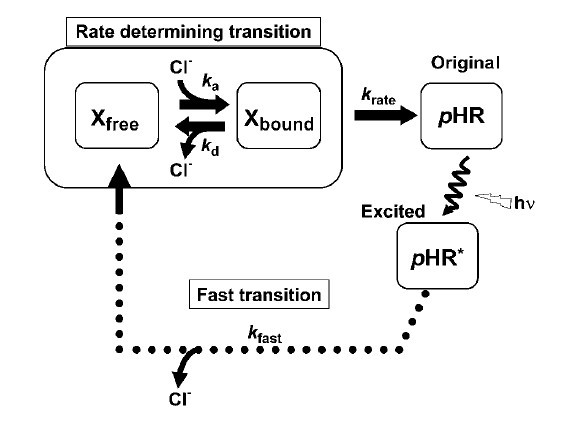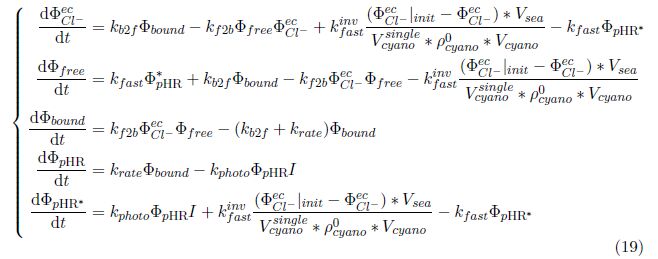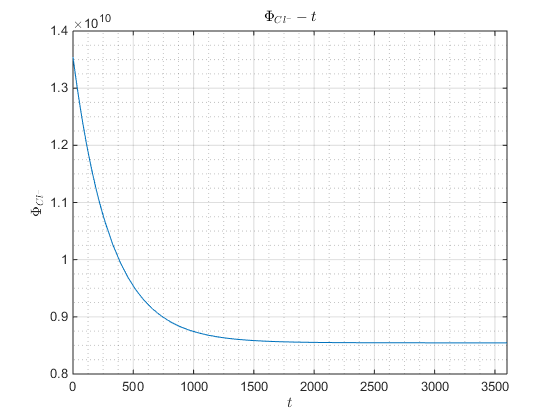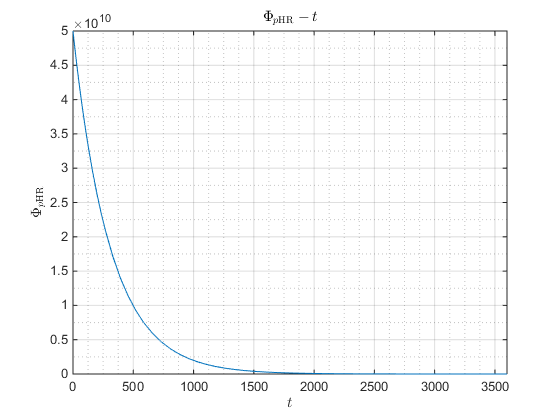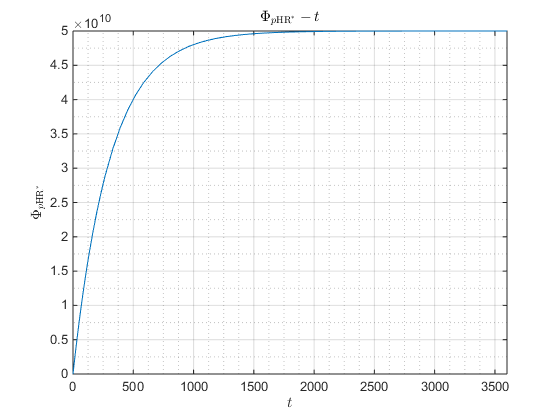Modeling
Contents
Abstract
In this part of modeling, our team will give a mathematical description of our bio-desalination system. The core process of our bio-desalination system is the active transport of chloride ion via activated pHR protein. Thus it is the main focus of our modeling. The very basic purpose of our modeling is trying to simulate the behavior our bio-desalination system therefore we could predict the evolution of some concerned variables in some degree. The most ideal prospect is to use our model to guide the practical industrial applications. Our model is based on the some published experimental data and comes from the view of chemical reactions. We show the modeling results in equilibrium situation and derive the ODEs(ordinary differential equations) system which describes the process in non-equilibrium situation. With appropriate setting with our model’s kinetic parameters, environment parameters and initial conditions, our model shows reasonable tendency and agrees well with experimental results.
Introduction
Overview
This section is trying to give a qualitative description of our team’s desalination tool. Before we enter the modeling part of this section, I want to give some basic ideas of our team’s project and some mathematical tools I will use during the modeling. Our team’s project focuses on the worldwide problem-shortage of fresh water. We try to modify the cyanobacterium via the methods and tools of biosynthesis. We want to implant the Natronomonas pharaonis halorhodopsin(pHR), which is an archaeal rhodopsin functioning as an inward-directed, lightdriven Cl− pump, into the cyanobacterium. We want to use this protein carried by cyanobacterium and driven by light energy to desalinate the sea water. That’s the very general idea of our project. At the meantime, we modify the corresponding promoter of pHR which makes the expression of pHR inhibited in dark environment. Such a promoter is just like a switch which could control the expression of pHR by the environment. Then, the whole working landscape of our modified cyanobacterium could be divided as following steps:
- Natural Growth
- Dark Expression
- Starving Working
I will explain each process in detail in the following sections.
Natural Growth Process
This process is just as straight forward as its name. In this process, we need our modified cyanobacterium grows naturally to a appropriate population number. The duration of this process is mainly determined by the target volume of sea water. It is plain in experiment sense. However, in modeling sense, we need a growth model to describe this process or have a method to measure the density in the end of this process. The reason I will explain later.
Dark Expression Process
In dark expression process, we put our modified cyanobacterium in dark environment. The duration of this process will directly affect the expression level of pHR. The expression level of pHR is critical for the next stage and modeling. In this process, we also need a dark expression model or a method to measure the average expression level of pHR in the end of this process because of the same reason as natural growth process.
Starving Working Process
Starving working process is the most important one. In this process, we need our modified cyanobacterium been in starving status. Then, provided with specific wavelength light, the pHR could transport the Cl− against the gradient of Cl− concentration and reach the purpose of desalination.
Modeling Intro.
As you can see, our team’s project involves a seris of processes. A complete modeling of our bio-system should at least consist of three model: growth model, dark expression model and starving working model. However, it is not necessary and also not wise to model all process one by one. Our focus should put on the last process-starving working process but it is obvious that the result of previous process could affect the fianl process significantly. Thus some parameters in the model of last process, we need obtain by experiment methods. Here I list some parameters reserved for previous processes or external environment:
- The density of cyanobacterium
- The expression level of pHR
- The intensity of light
- The initial concentration of Cl−.
Modeling
Before we begin our modeling work, we need to make our aim clear. The reason of modeling is we want to use the intrinsic logic of mathematics to reveal the still unclear part in this relevant problem. However, the very difficult part in modeling biosystem is the biosystem is a complex system. The varibles and processes involved are complicated to consider. In our project, the very first thing we need to unstand is what happened in the starving working process? This part we mainly rely on the published papers results. Only when we have some basic ideas about this process, we can do something more. Then, we need to choose mathematical tools to describe our model. In our problem, the process is very mysterious for us and not easy to describe quantitatively. But we know that no matter how complicated the process is, some fundamental laws must be obeyed. If we see our problem in microscopic level, this process should dominate by electromagnetic law. Therefore, the method of molecular dynamics could be applied. But the computation cost is not affordable, the accuracy is not suitable for our purpose and the method is too difficult for us. Then we need to simplify the problem. In order to achieve this,our team rise the observation level a little higher. We choose the very fundamental law-conservation law.
Assumptions
As I have mentioned before, our model will based on conservation law. I choose to model our system in a very simple case in macroscopic level. To achieve this, I need some assumptions.
- The cyanobacterium density is not too high, then each cyanobacterium could be regareded as independent one.
- During starving working process, once provided continuous illuminations, each reactions in this process reach equilibrium quickly.
- Ignore the spatial distribution of concentrations or other possible quantities. Assume these quantities in our concerned space is sufficiently homogeneous.
- Assume the effect of each cyanobacterium could be simply linear superposition.
Variables
- The extracellular concentration of Cl−: Φ Cl− ec
- The cytoplasmic concentration of Cl−: Φ Cl− cp
- The light intensity: I
- The pHR expression level: Φ pHR 0
- The cyanobacterium density: ρ cyano 0
- The volume of cyanobacterium growth medium: V cyano
- The volume of a single cyanobacterium: V cyano single
- The volume of target sea water: V sea
- The Cl − -free intermediate concentration: Φ free
- The Cl − -bound intermediate concentration: Φ bound
- The concentration of original pHR: Φ pHR
- The concentration of excited pHR: Φ pHR ∗
- The chemical reaction constant of fast transition process: k fast
- The chemical reaction constant of rate determining process: k rate
- The chemical reaction constants of intermediate reaction: k f2b , k b2f
- The proportiality of pHR to pHR* process: k photo
- The concentration of all pHR involved in the photo-induced cycle: φ ∗
- The ratio of excited pHR to unexcited pHR: κ
Details
The detail of our model will be explained in this part. The process division is mainly based on published paper result. As shown in the figure 5.1.1, the whole cycle in this process could be divided into two parts: one is the fast transition of intermediates corresponding to Cl− translocating and releasing processes, and the other is the rate-determining transition corresponding to Cl− binding processes. Use the law of mass action in chemical reaction theory, we could have following equations:
Note that the total amount of pHR φ∗ involved in the photo-induced current cycle is:
With our previous assumptions, all reaction processes reach equilibrium quickly under continuous illumination. Thus all left side of above equations could approximate by zero. Then solve these equation system, we could find that:
We also have that the conserved quantity-the pHR expression level: Φ0pHR , which equals to:
where Φ0pHR is determined by dark expression process. According to the experiment result, we note that the excited pHR concentration φ∗ should be a function of light intensity I, i.e.
In order to write this relation explicitly, we rewrite the excited pHR concentration φ∗ :
where κ = φ∗ / ΦpHR . Therefore, the effect of light intensity could be writtten as:
The relation between excited to unexcited ratio κ and light intensity I should be determined by experiment or other methods.
If we consider the photoinduced current Iphoto , we could obtain that:
where F is the Faraday’s constant. Note that krate is much smaller than any other constants. Then we can do some simplification.
Let Iphotomax = krate φ∗ F , thus the equation could be reduced as the form of Michaelis-Menten-type equation:
Until now, we have made a progross but still far away from solving the problem. Remember that all these results are based on fast equilibrium approximation. This approximation gives us some good results but also troubles. If we want to model the whole process of our system, how could we just consider the situation in equilibrium? Only these results in equilibrium situation is not sufficient to predict the behaviors of this complex system.
Now consider the change of concentration of Cl− in non-equilibrium situation.
where the transportation term is used for describing the pHR active Cl− transport process. However, this term is not easy to write explicitly. If we divide the non-equilibrium process into small time segment and regard each segment as quasi-equilibrium, we could use the previous equilibrium results to describe the transportation effect, i.e.
However, here is another thing peculiar we should pay attention to. The Φ Cl− cp and extracellular intermediates Φ free are separated in space . Therefore, the active transportation carried by pHR protein pHR ∗ → Clcp- + Intfree process should be mainly affected by the concentration of Cl-. Then, our team simply wrap out Φfree in the transportation term to reflect the effect of intracellular concentration of Cl- while ignore the extracellular effect caused by intermediate.
Consider the photoreaction process which activates the original state pHR to active state pHR ∗.Note the figure 1, we could write following equations:
where the term N pHR → pHR ∗ stands for the number of pHR ∗ converted from original pHR in unit time in photoreaction process. However, this effect is not easy to describe explicitly just as the effect of light intensity upon photoinduced current which has been mentioned before. In order to proceed, I will add another two assumptions for the photoreaction process which are:
- Photoreaction rate is propotional to the concentration of pHR, i.e. N pHR → pHR ∗ ∝ ΦpHR
- Weak illumination assumption. Under this assumption, it's reasonable to assume that photoreaction rate is proportional to the intensity of illumination, i.e. N pHR → pHR ∗ ∝I
With these two assumptions, the term N pHR → pHR ∗ could be denoted as:
Please note that the proportional constant k photo is not the meaning of reaction constant. Combine with other two obvious equations, we can obtain the final equation system:
However, until now it is still insufficient to solve this equation system. There are six unknows: Φ Cl− ec , Φ bound , Φ free , Φ pHR , Φ pHR ∗ and Φ Cl− cp while only five independent equations. We still need one more equation. Now it's time to use the conservation law of Cl - , i.e.
Do some simple calculations, we obtain that
Then, substitute this equation into above equation system,
Note the initial conditions:
Theoretically speaking, we can solve this system to simulate the process and predict the concentration of Cl− . The simulation result will present in the next section.
Simulation
This model's simulation is pretty straight forward. The main calculation of this simulation is calculating this equation system in five-unkonwns.
What we want is the real-time variation of the concentration of chloridion in the medium, with which we can calculate the desalination efficiency of our system.Besides, the state of halorhodopsin is also important.
Conclusion
From the result, we can see that our model works well for it has reached a stable point in the desalination process. But because of the strong assumptions, the model cannot predict the accurate behavior of the whole system. For instance, the results are reasonable only when the density of cyanobacteria is very high. Instead, we could use the approximate result to estimate the rough actual productive rate. In fact, even though our experimental result is more complex and unaccountable by formulas and equations, knowing the tendency is still important for us.
The model focus on the real-time concentration of chloridion variation which seems redundant, but in fact, for the process is much complicated, we need a more distinct understanding when we need to modify the desalination process craft. For example, when the starved cyanobacteria generate enough energy from light after working for hours, it begin pumping out the redundant ions. This is against our idea and we can use the real-time concentration of chloridion variation result to find an optimized craft.
Now, we can choose appropriate parameters to optimize the model by more experiment data, and provide the proper instruction for the user who wants to design the flow control of the sea water desalination assembly line.
Reference
[1] Heterologous Expression of Pharaonis Halorhodopsin in Xenopus laevis Oocytes and Electrophysiological Characterization of Its Light-Driven Cl− Pump Activity Akiteru Seki et al. Biophysical Journal Volume 92 April 2007 2559–2569 2559
[2] Mathematical Physiology James Keener James Sneyd ISBN 978-0-387-75846-6
